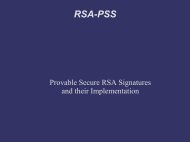RSA-PSS â Provably secure RSA Signatures and their ...
RSA-PSS â Provably secure RSA Signatures and their ...
RSA-PSS â Provably secure RSA Signatures and their ...
You also want an ePaper? Increase the reach of your titles
YUMPU automatically turns print PDFs into web optimized ePapers that Google loves.
PKCS #1 v2.1 specifies the use of <strong>PSS</strong> with either SHA-1 or one of the SHA-2 (SHA-256, SHA-384, SHA-512) algorithms. Later st<strong>and</strong>ards like RFC 4055(<strong>PSS</strong> signatures for X.509) additionally allow SHA-224. The proposed defaultis SHA-1.However, it is highly suggested not to use SHA-1 anymore. We alreadydiscussed the weaknesses of still widely used hash functions MD5 <strong>and</strong> SHA-1in chapter 2.5. Up until now, the SHA-2-family (SHA-224, SHA-256, SHA-385, SHA-512) can be considered <strong>secure</strong> <strong>and</strong> is the only widely accepted hashst<strong>and</strong>ard without known weaknesses.As <strong>PSS</strong> is a safety measure against unknown attacks, it barely makes anysense to use it with SHA-1, where attacks are already known. The switch fromMD5/SHA-1 to SHA-2 should have a higher priority than the implementationof <strong>PSS</strong> padding.6.2 Key SizeFor a long time, <strong>RSA</strong> key sizes between 512 <strong>and</strong> 768 bit were quite common.They should be considered completely in<strong>secure</strong> today, although they still canbe found in real-world applications. In 2010, a research team factorized a 768bit number [Kleinjung et al., 2010]. In 2009, it was possible to factorize a 512bit key used for signing the operating system of a Texas Instruments calculatorby a private person on a home computer [ticalc.org, 2009]. Those attacks havealso questioned the security of <strong>RSA</strong> with 1024 bit.In 2003, Adi Shamir (one of the original <strong>RSA</strong> authors) proposed a theoreticaldesign for a hypothetical device called TWIRL (The Weizmann Institute RelationLocator) that would be capable of factoring large numbers up to 1024 bitin less than a year with a 10 million dollar device [Shamir <strong>and</strong> Tromer, 2003].This would fully break <strong>RSA</strong> with a key size of 1024 bit or lower, meaning thatthe private key can be revealed with knowledge of the public key.Due to the high costs, nobody has publicly built a TWIRL device. However,as with the transition to new hash functions, the transition to key sizes above1024 bit should have higher priority than the transition to <strong>PSS</strong> <strong>and</strong> while intheory possible, it barely makes sense to use <strong>PSS</strong> with a <strong>RSA</strong> key size of 1024bit. <strong>RSA</strong> Inc. as well as the NIST propose not to use 1024 bit keys after 2010any more.6.3 ExponentIn its early days, <strong>RSA</strong> was done with a r<strong>and</strong>om, large-sized exponent. Later,it became prevalent that for better performance in the encryption / verificationprocess, very small exponents like e = 3 could be used. Textbook <strong>RSA</strong> incombination with a small exponent raises a number of issues, but all of themcan be avoided with padding <strong>and</strong> hashing.25



